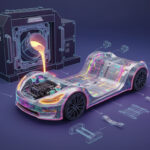The world of electronics is evolving rapidly, and at the heart of most electronic devices lies a critical component known as the PCBA. Standing for Printed Circuit Board Assembly, a PCBA refers to a completed board that consists of all the electronic components mounted on a bare PCB (Printed Circuit Board). Understanding the meaning of PCBA and recognizing its importance is crucial for anyone involved in electronics, whether as a designer, manufacturer, or end user.
What is PCBA?
A Printed Circuit Board Assembly (PCBA) is produced by assembling electronic components such as resistors, ICs, connectors, and capacitors onto a PCB. This is done using techniques like Surface Mount Technology (SMT) or Through-Hole Technology (THT), making the PCB not just a passive base but an active, functional electronic module.
The process of producing a PCBA begins after the manufacturing of the bare PCB, which only consists of the substrate and the copper traces. Once the electronic components are placed and soldered, the final board becomes a PCBA. It is this assembled form that powers devices ranging from smartphones and home appliances to medical equipment and industrial machinery.
[ai-img]circuit board, electronic assembly, microelectronics[/ai-img]
PCBA vs PCB: Understanding the Difference
It’s essential to distinguish between PCB and PCBA. A PCB, or Printed Circuit Board, is the blank board without components. It’s typically made from fiberglass, composite epoxy, or other laminate material, with copper paths to connect electronic components. On the other hand, a PCBA has all components soldered to the board, ready to perform specific functions as part of an integrated system.
This differentiation is important, especially in manufacturing and supply chain contexts. A company may receive bare PCBs from one source and assemble them internally or through an external service, eventually turning them into fully functional PCBAs.
Importance of PCBA in Electronics
The importance of PCBA in electronics cannot be overstated. Nearly every modern electronic device includes at least one PCBA. Its role is to create a compact, reliable, and robust system able to perform electrical functions. Here are a few reasons PCBAs are vital:
- Compact Design: PCBAs enable the design of smaller and lighter electronic devices by tightly integrating components.
- Efficiency and Performance: Proper PCBA design ensures devices operate efficiently, with reduced power consumption and heat generation.
- Automation and Mass Production: SMT assembly lines allow manufacturers to produce PCBAs in large quantities with high reliability and consistency.
- Error Reduction: Automation limits human error, making PCBAs more accurate and reliable than hand-wired circuits.
[ai-img]factory, pcba production, automated assembly[/ai-img]
Industries like automotive, aerospace, consumer electronics, and healthcare depend heavily on the reliability of PCBAs because their performance directly affects product safety and functionality.
PCBA Manufacturing Process
The PCBA manufacturing process includes several intricate stages:
- Solder Paste Application: A stencil applies solder paste to designated areas on the PCB where components will be mounted.
- Component Placement: Pick-and-place machines position sensitive electronic components precisely on the board.
- Reflow Soldering: The board passes through a reflow oven, where solder paste melts and solidifies to secure components.
- Inspection and Testing: Quality control techniques like Automated Optical Inspection (AOI), X-ray, and functional testing detect any errors or failures.
Some assemblies also include manual soldering or additional washing steps to meet specific conformity or environmental standards, especially in medical or military applications.
FAQs About PCBA
- Q: What does PCBA stand for?
A: PCBA stands for Printed Circuit Board Assembly, which is the final stage where electronic components are mounted and soldered onto a bare PCB. - Q: Is PCBA the same as a PCB?
A: No, a PCB is the physical board before any components are added. PCBA is the assembled board with all components in place, ready for use. - Q: What technologies are used in assembling PCBAs?
A: Surface Mount Technology (SMT) and Through-Hole Technology (THT) are commonly used to mount components onto the PCB. - Q: Why is PCBA important in electronics manufacturing?
A: PCBA enables compact, efficient, and high-performance electronic systems used in virtually all modern devices. - Q: What types of devices use PCBA?
A: From smartphones and televisions to medical implants and spacecraft systems, most electronic devices rely on one or more PCBAs.
In conclusion, understanding PCBA and its role in electronic design and manufacturing is fundamental for developing modern electronics. As technology continues to advance, PCBAs will remain at the core of innovation, making devices smaller, smarter, and more efficient.









